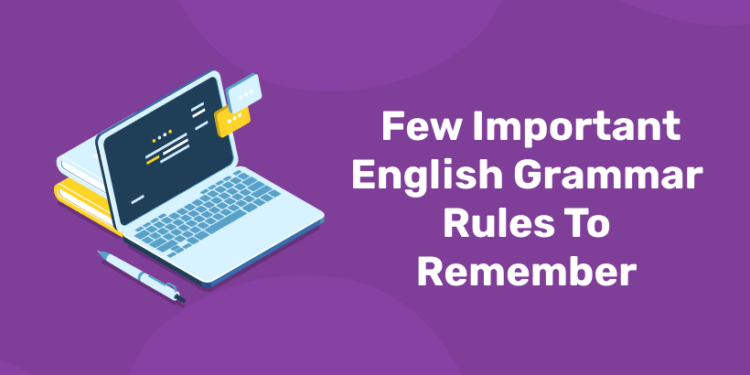One of the most challenging things about learning a new language is learning the grammar rules. And while English grammar can seem fairly easy compared to some languages, a small error can easily change the meaning of what you want to say. The English language can be hard to perfect. A lot of people will say English is a tough language to learn; there are a lot of rules to remember, and many words and phrases merely don’t follow them.
Important English Grammar Rules
Remembering everything can be a massive task, especially when you’re also trying to learn pronunciation, recognize different regional dialects, and master punctuation and spelling. Inventing a solid foundation of grammar is the first thing you should do when you begin to learn a new language; and once you get your head around the basics, the rest will come easily. We’ve spread out a few of the more common ground rules that will allow you to make sure you aren’t making any apparent errors.
So here’s a list of some essential rules that you should keep in mind when you speak and write English.
-
Adjectives and adverbs
Make sure you use adjectives and adverbs accurately. Adjectives define, identify and quantify people or things and usually go in front of a noun. They don’t switch if the noun is plural. Adverbs alter verbs, adjectives, and other adverbs and usually come after the verb. For instance:
- He’s a slow driver. (adjective)
- He drives slowly. (adverb)
Most adverbs are formed by adding -ly to an adjective as in the instance, but a few adverbs are irregular, such as:
fast (adjective) – fast (adverb)
hard (adjective) – hard (adverb)
good (adjective) – well (adverb)
For instance, Your English is good. You speak English well.
Sign Up for ENTRI Learning App to Learn More About Grammar!
-
Pay attention to homophones
Homophonic words are words that are pronounced exactly as other words but have distinct meanings, even if they are spelled differently. This can make confusion and unfortunately, there are many of these words in English. For example:
- they’re – their – there
- you’re – your
- it’s – its
- I – eye
- here – hear
- break – brake
- flower – flour
- our – hour
So when you’re writing, be mindful to pick the right spelling. And when you listen, remember that a word you assume you understood may have another meaning. Try to understand that connotation from the context.
-
Use the correct conjugation of the verb
Remember to alter the verb to agree with the subject. The main subjects you ought to be careful with are he, she, and it because they often have a distinct form from the others. For instance:
She has two cats. RIGHT
She have two cats. WRONG
This seems like a small error to make but unfortunately, it’s a very apparent one. So if you can avoid it, it’ll make a big distinction in how accurate your sound is.
Remember also that when you explain something using ‘There is/are’, the verb must agree with the first item you mention. For example:
There is a couch, some chairs, and a table.
There are some chairs, a table, and a sofa.
-
Connect your ideas with conjunctions
If you want to combine two ideas or short phrases, you can do so by using a conjunction. For instance,
I’m studying English. English is essential.
becomes:
I’m studying English because it’s essential.
The most common conjunctions are:
and – addition
because – to give the reason
but – to express contrast
so – to describe a consequence
or – to describe an alternative
Here are some instances:
- He likes Cricket and he plays in a team.
- We’re going out because we’re bored.
- He wants to study more but she doesn’t have time.
- Jim is coming round so I’m cleaning my flat.
- Would you prefer tea or coffee?
-
Sentence construction
Normally speaking, sentences in written English are not particularly long. This is good news for English learners because it implies you don’t require to worry about writing long, complex sentences. A sentence usually contains two, or maybe three, clauses (subject + verb + object), linked by a conjunction (see above).
A good practice to make your sentences even clearer is to add commas. Commas help the reader understand where one phrase finishes and another starts. The most common circumstances where it’s recommended to put a comma are:
- between two clauses. For instance, If the weather is nice tomorrow, we’re going to the park.
- to divide items into a list. For instance, Our kids like swimming, skiing, ice-skating, and cycling.
- after some conjunctions. For instance, Our holiday was great and the hotel was wonderful. However, the weather was awful.
- for additional knowledge in the middle of a sentence (a non-defining clause). For instance, My neighbor, who’s from Brazil, is good at cooking.
And don’t forget to begin every sentence with a capital letter!
-
Remember the word order for questions
In English, the structure of questions is separate from the affirmative form. So make sure you remember to modify the order of the words or add the auxiliary ‘do’. There are four modes to make questions in English:
- ‘to be’ – for questions employing the verb ‘to be’, switch the subject and verb. For example, Are you a student?
- all other verbs – to construct questions for all other verbs, add the auxiliary ‘do’. For example, Do they work here?
- modal verbs – to construct questions with modal verbs, invert the modal verb and the subject. For example, Can he play the keboard?
- auxiliary verbs – for sentences including an auxiliary verb, like ‘’have’ in the present perfect, switch the auxiliary verb and the subject. For example, Have you seen Bob?
These rules are still used when you add a question word like what, how, why. For example:
Where are you from?
When can we meet?
Why have they left?
-
Use the right past form of verbs
Speaking about the past in English is not quite difficult. Every subject employs the same word to describe the past, so you don’t have to worry about learning six distinct words as in some languages. However, many verbs are irregular and don’t obey the regular form of adding -ed. You don’t require to know all of these, but try to learn the most common ones (approximately 20). For instance,
Go – went
Have – had
Make – made
For example,
- We went to the cinema last Saturday.
- They had a party to celebrate John’s birthday.
- I made a cake this morning.
Sign Up for ENTRI Learning App to Improve Your Spoken English!
-
Get acquainted with the main English verb tenses
If you’re just beginning to learn English, you won’t know all the tenses yet. And that’s okay. Just concentrate on becoming acquainted with the four or five that are used most frequently. Seek to be able to use these:
- Present simple – to express habits and permanent situations. For instance, We live in America.
- Present continuous – to explain current situations and future plans. For instance, I’m meeting John later.
- Past simple – to represent completed past actions. For instance, They arrived at 3 p.m.
- Present perfect – to explain past actions connected to now. For example, We’ve completed the reports.
- Will – to express future actions. For instance, I’ll meet you in front of the conference center.
-
Never use a double negative
In English, there are often two ways to communicate a negative concept. For instance, if you want to say the room is empty, you can say:
There is nothing in the room. OR There isn’t anything in the room.
The words ‘nothing’ and ‘anything’ has the same connotation, but ‘nothing’ is used with an affirmative verb, and ‘anything’ is operated with a negative verb.
This rule uses to other words like:
nobody – anybody
none – any
This is also right of the word ‘never’ when you talk about the experience. You can say:
He’s never been to the U.S. OR He hasn’t ever been to the U.S.
The meaning is the same but in the second sentence the use of ‘ever’ means you need to make the verb negative.
Learning all these grammar rules takes time and you also need some guidance to be capable to put them into practice. The best way to become confident and professional in using them is to practice in a supporting and fun environment with experienced teachers. Find out more about Our Method on ENTRI Learning App now.













